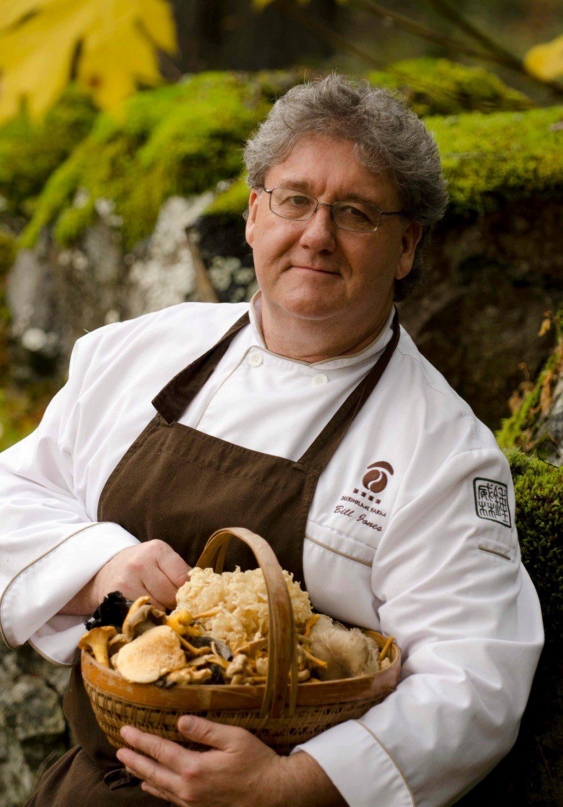
The late Canadian culinary icon James Barber declared mushrooms “marvellous.” If you agree and want to learn all about them, Bill Jones, a chef and friend of Barber, has published a book: The Deerholme Mushroom Book: From Foraging to Feasting (Touchwood Editions, $29.95).
This 256-page, photo-rich, information-packed tome is named after Deerholme Farm, Jones’s Cowichan Valley culinary destination that offers cooking instruction and fine dinners inspired by nearby vineyards, farms and forests. Those forests are rich with wild mushrooms, but it was an overseas location that sprouted Jones’s interest in all things fungi.
Jones’s education and first career was in geology. But his enthusiasm for cuisine simultaneously simmered . When it began to boil, he could no longer resist the urge to switch directions and left his Calgary home to do so.
“I was 28 and enrolled in a cooking school in England. Part of the course was a stage apprenticeship in France. I was sent to La Cheneaudière, a two-star Michelin restaurant in Alsace,” Jones said.
At that fine-dining establishment, local mushroom foragers brought baskets of fresh cepes, also called porcini mushrooms, to the back door and Jones was awestruck by their incredible flavour and texture.
“I managed to talk one of the foragers into showing me the ropes. I had to promise never to return [to the area we went], and buy him lots of beer,” Jones said. “He showed me the poisonous and edible varieties and also which types of trees and terrain to look for. I was hooked on edible mushrooms and never looked back.”
Jones, 53, has developed an encyclopedic knowledge of mushrooms. Part of that education has meant harvesting and sampling mushrooms around the world. While doing so, he discovered mushrooms, like wine grapes, grow and taste different depending on climate and terroir.
“I have been fortunate to have picked mushrooms in several locations. Here on the West Coast, we live in a temperate rainforest; we get lots of rain, which produces large specimens,” Jones said. “In other provinces the mushrooms are smaller and sometimes more concentrated in flavour.”
The Deerholme Mushroom Book is packed with things Jones has learned about mushrooms, including concise information on foraging and harvesting, such as preferred varieties, when to pick and, very importantly, planning a safe outing.
“New foragers tend to stress out over the potential of eating a poisonous mushroom. Truth be told, you are far more likely to fall prey to the environment around you,” Jones writes in the book.
The areas where the mushrooms are found can be inhospitable places with mossy slopes, sinkholes and animals, such as bears, waiting to greet you. Because of that, Jones wisely includes a section in the book dedicated to making you as prepared as possible, such as what gear to bring, what to do if you get lost and, beyond reading his book, how to further educate yourself before going solo.
“You should have a basic understanding of the edible varieties and any poisonous varieties that lurk out there. Join the local mycological society or join a foraging class [like those offered at Deerholme Farm] to fast-track your education. A good guidebook, based on local mushrooms, is also a nice resource to have,” Jones said.
If foraging for your own mushroom sounds daunting, Jones’s book also includes a bounty of information on the types of wild mushrooms, such as chanterelle, morel, porcini and pine, you can buy at farmers’ markets and some grocery stores. It gives the same room and respect to commercially grown mushrooms, such as white button, cremini, shiitake, enoki and oyster mushrooms, offering advice on storing, cleaning and, of course, purchasing.
“Mushrooms are like any other vegetable. Browning is often the sign of a decaying mushrooms. Choose mushrooms that are plump, smooth-skinned and appear dry,” Jones said.
Jones’s book also enlightens you on truffles and, if you are real keener, how to grow your own mushrooms. His book is also packed with cooking tips and includes more than 140 globally inspired recipes, such as mushroom hummus, mushroom and chorizo flatbread, mushroom and crab cakes, grilled oysters with porcini and mushrooms, and hunter-style chicken.
“This book has taken me 10 years to write and it builds off my previous book, The Savoury Mushroom. It’s meant for people who love good food and are curious about the world around us. The recipes are simple and straightforward and rely on ingredients you can find in the marketplace or your local farmers’ market.”
The Deerholme Mushroom Book can be purchased at local and national bookstores and online.
To learn about Jones’s upcoming mushroom foraging classes and dinners, go to his website magnorth.bc.ca and click on events. If you interested in learning about and/or joining a mycological society, the one in our area is the South Vancouver Island Mycological Society.
Wild Mushroom Salad with Cauliflower, Dill, and Rosehip Vinaigrette
Rosehip butter is packed full of nutrients and vitamin C. You may have to search a little to find it in health-food stores or in specialty food shops catering to Germanic and Nordic clients. Alternately, you can find rosehip syrup in some stores and it makes an acceptable substitute for the butter. You can also use apple butter or even orange marmalade as a nice substitute.
























